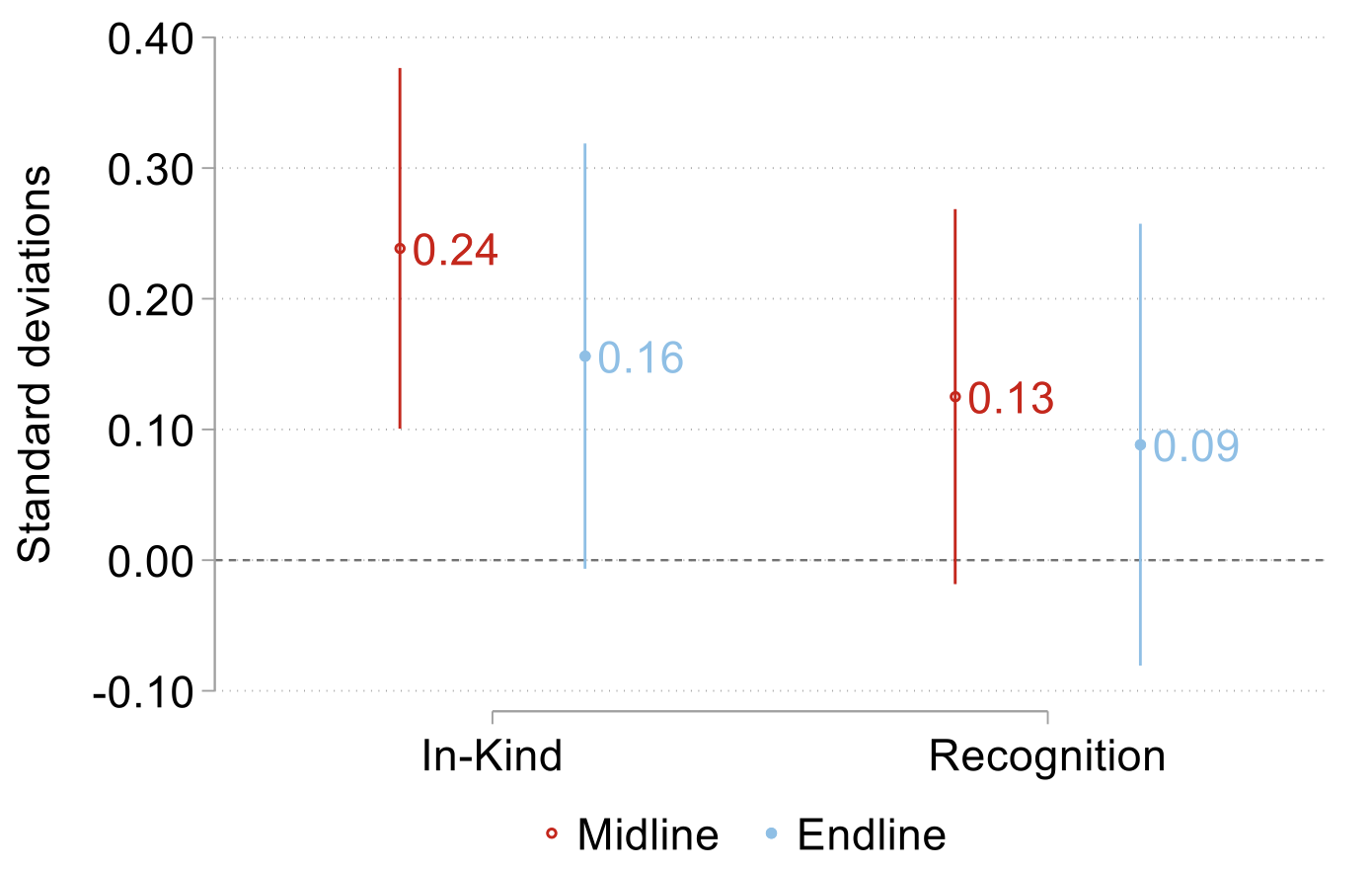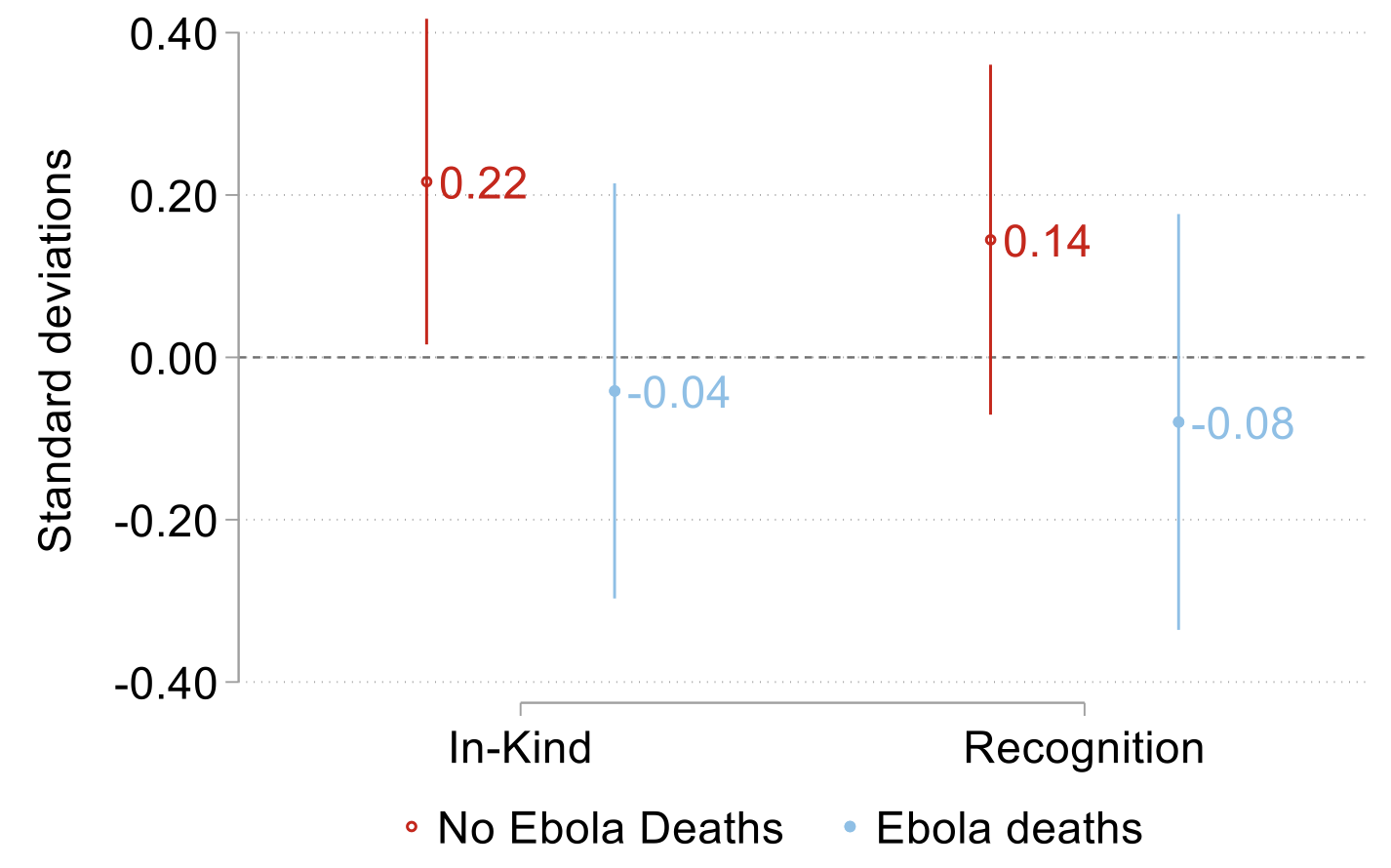
Public recognition rewards for well-performing public-sector teachers are less effective than in-kind rewards at improving student learning
Developing countries across the world are facing a ‘learning crisis’ where students are simply not learning enough at school (World Bank 2018). One promising approach to improving learning is to provide stronger incentives for teachers. The rationale is that teacher pay, promotion, and tenure are typically not linked to performance metrics in the public sector. In contrast, private school teachers and contract teachers – both of whom have weaker job security – tend to out-perform public sector teachers in several countries, despite having lower levels of education.
Some studies have now shown that teacher financial incentives can improve student learning levels (Behrman et al. 2015, Filmer et al. 2020, Leaver et al. 2021, Loyalka et al. 2019, Muralidharan and Sundararraman 2011). However, few governments (if any) have adopted them at scale. This could be due to political reasons – teacher trade unions are often opposed to them – or ideological resistance to the idea. In contrast, governments frequently implement policies or informal systems that reward high-performing civil servants through public recognition, such as award ceremonies or certificates. We know from other contexts that non-financial incentives can incentivise good behaviour (e.g. Ashraf et al. 2014). However, we are not aware of studies examining the causal impact of non-financial incentives on the behaviour of public civil servants in developing countries.
Can performance-based rewards giving teachers recognition for good performance result in better student learning outcomes? How does their impact compare with provision of in-kind rewards?
We answer this question in the context of Guinea, one of the poorest countries in the world (Barerra-Osoria et al. 2022). A nationally representative sample of 420 public primary schools were assigned to one of three treatment arms. In 140 of the schools, relatively high-performing teachers were rewarded in-kind, with the value of goods increasing with level of performance (sacks of rice, radios, phones, televisions, and generators). In another 140 schools, relatively high-performing teachers received a certificate and public recognition from government. The remaining 140 schools were assigned to the control group. Performance was calculated using a weighted average of (i) the annual gain in the average score of the teacher’s students on standardised tests; and (ii) the teacher’s annual improvement in the quality of his/her lessons preparation and delivery, as measured during inspection visits.
In-kind incentives more effective than public recognition
We find that rewarding well-performing teachers in-kind was almost twice as effective at improving student learning than rewarding them via a public recognition campaign. After one year of implementation, the in-kind programme improved student learning by 0.24 standard deviations. In contrast, the recognition programme had a smaller and statistically insignificant effect of 0.13 standard deviations.
Figure 1 Impacts on student learning by treatment arm and time of data collection

Notes: Lines indicate 90% confidence intervals. Red dots indicate treatment effect sizes (in standard deviations) at the end of the first year of implementation; blue dotes indicate treatment effects at the end of the second year.
Ebola disrupts learning performance and erodes programme effectiveness
The aforementioned effects dissipated in the second year, most likely due to the onset of Ebola. Student learning improved by a smaller and statistically insignificant 0.16 and 0.09 standard deviations in the in-kind and recognition treatment arms respectively. The second year of the programme coincided with the outbreak of Ebola in Guinea, and some regions were harder hit than others. We find that for both programmes, treatment effects were substantially smaller in Ebola-affected prefectures. There was zero effect in the prefectures most exposed to Ebola, and the effect sizes were similar to the midline results in the areas not affected by Ebola.
Figure 2 Impacts on student learning by treatment arm at endline, by exposure to Ebola

Notes: Lines indicate 90% confidence intervals. Red dots indicate treatment effect sizes in prefectures where there were no reported deaths due to Ebola by the time of endline data collection. Blue dots indicate treatment effect sizes in the remainder of the sample.
Female teachers more incentivised by recognition rewards
The impact of the recognition reward depended on the gender of the teacher. Only female teachers responded to the recognition reward programme (an impact of 0.23 for female teachers, and 0.01 for male teachers). In contrast, both male and female teachers responded equally well to the in-kind reward.
This heterogeneity by gender is the most surprising result. The original experiment was not set up to test for this; still, the difference in responses between female and males is quite telling. We can only speculate on the possible reasons. Perhaps female teachers receive less recognition from society overall, and thus respond more strongly to the prospect of getting recognition. Or perhaps female teachers’ identities are more closely linked to their profession (i.e. they really care about teaching), and consequently they place a higher value on being recognised for their work.
We have suggestive evidence for the latter mechanism. As a coarse measure of identity, we asked teachers which profession they would choose if they could choose again. Female teachers were 10 percentage points more likely to state that they would choose teaching, suggesting that they do value their profession more than male teachers. Moreover, there is similar heterogeneity of treatment effect sizes across this dimension: both types of teachers responded equally to the in-kind rewards programme, but only teachers whose preferred profession is teaching responded to the recognition rewards programme.
Ultimately the motivations of teachers are poorly understood – potentially lying between intrinsic motivation linked to the welfare of students (typically emphasised by educators) and extrinsic motivation driven by the structure incentive of contracts (typically emphasised by economists). This suggests a rich policy-relevant research agenda aimed at more fully characterising these motivations. Better designing programmes such as the one studied here will depend on that understanding.
References
Ashraf, N, O Bandiera, and B Kelsey Jack (2014), “No margin, no mission? A field experiment on incentives for public service delivery”, Journal of Public Economics 120: 1-17.
Barrera-Osorio, F and D Raju (2017), “Teacher performance pay: Experimental evidence from Pakistan”, Journal of Public Economics 148: 75-91.
Barrera-Osorio, F, J Cillier, M H Cloutier, and D Filmer (2021), “Heterogenous Teacher Effects of Two Incentive Schemes: Evidence from a Low-Income Country”, Journal of Development Economics, forthcoming.
Behrman, J R, S W Parker, P E Todd, and K I Wolpin (2015), “Aligning learning incentives of students and teachers: Results from a social experiment in Mexican high schools”, Journal of Political Economy 123(2): 325-364.
Filmer, D, J Habyarimana, and S Sabarwal (2020), “Teacher performance-based incentives and learning inequality”, World Bank Policy Research Working Paper No. 9382.
Leaver, C, O Ozier, P Serneels, and A Zeitlin (2021), “Recruitment, effort, and retention Effects of performance contracts for civil servants”, American Economic Review 11(7): 2213-2246.
Loyalka, P, S Sylvia, C Liu, J Chu, and Y Shi (2019), “Pay by design: Teacher performance pay design and the distribution of student achievement”, Journal of Labor Economics 37(3): 621-662.
Muralidharan, K and V Sundararaman (2011), “Teacher performance pay: Experimental evidence from India”, Journal of Political Economy 119(1): 39-77.




